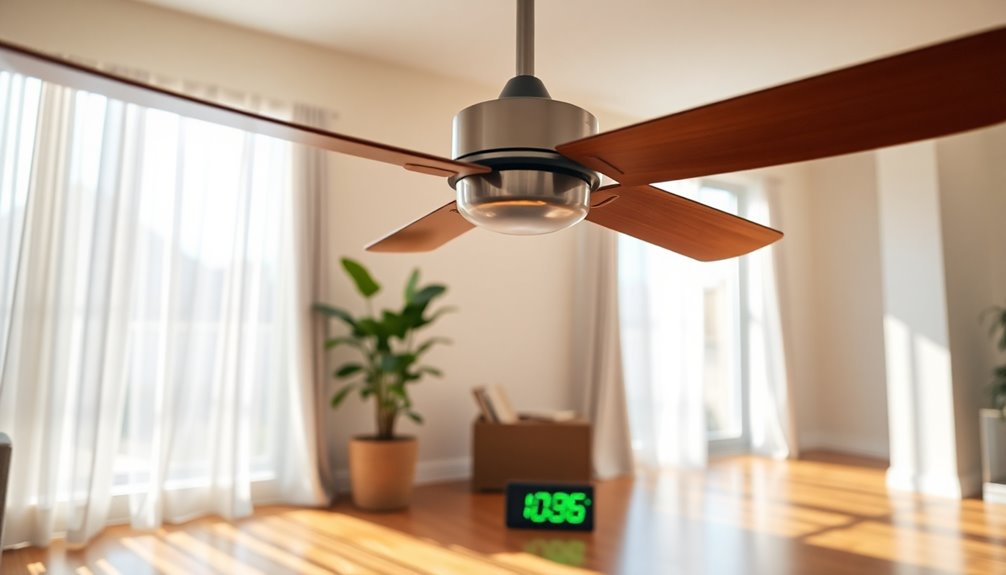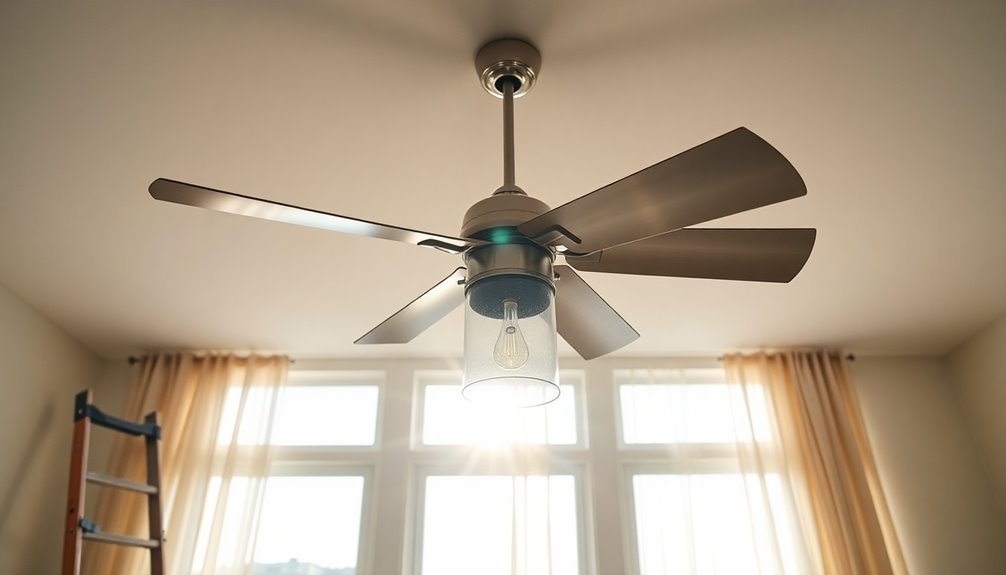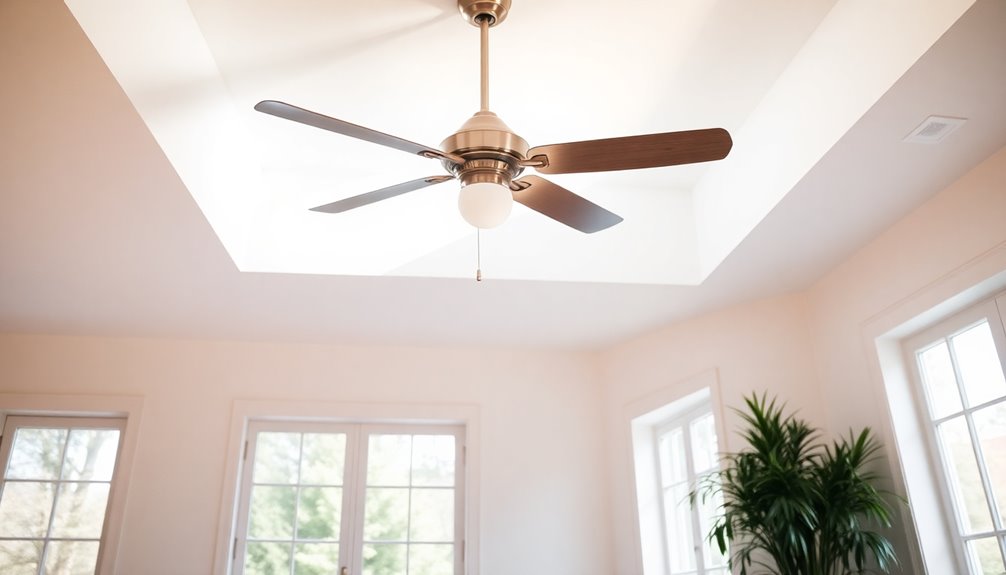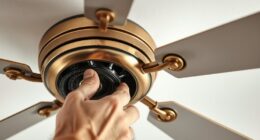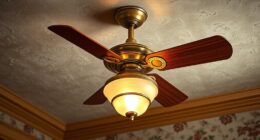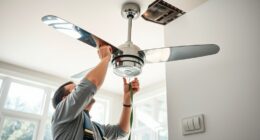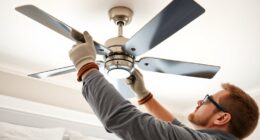In winter, you should set your ceiling fan to spin clockwise. This creates an updraft that pulls cooler air upward and pushes warm air down, helping to keep your room cozy. Running the fan at low speed is best; it circulates warm air without creating drafts. You'll notice enhanced comfort, especially in rooms with high ceilings. Plus, this simple adjustment can lower your heating costs by up to 15%. Don't forget to use the reversing switch typically located on your fan to make the change. There's so much more about optimizing your fan's efficiency you might want to explore.
Key Takeaways
- In winter, ceiling fans should rotate clockwise to create an updraft, pushing warm air downwards and promoting even heat distribution.
- Running the fan at low speed prevents drafts while maintaining warmth, ensuring comfort throughout the room.
- Adjusting the fan direction can reduce heating costs by up to 15% by effectively redistributing warm air.
- High ceilings benefit significantly from clockwise rotation, helping warm air descend and enhancing overall comfort.
- To change direction, use the reversing switch after turning off the fan; regular maintenance ensures optimal performance.
Importance of Ceiling Fan Direction

The direction of your ceiling fan in winter is essential for maintaining a comfortable indoor environment. By setting your ceiling fan to rotate in a clockwise direction, you create an updraft that pulls cold air upward and pushes warm air down towards the floor. This simple adjustment helps distribute heat more evenly throughout the room, enhancing your overall comfort during the colder months.
Not only does proper ceiling fan direction improve comfort, but it can also lead to significant savings on your utility bills. By allowing for lower thermostat settings, you can reduce your energy consumption by 15% or more.
Running your fan at low speed during winter prevents drafts while still effectively circulating warm air, avoiding the discomfort that comes with higher speeds.
Most ceiling fans come equipped with a reversing switch, usually located near the fan base, making it easy for you to change the direction. Taking the time to adjust your fan can drastically improve your indoor climate and save you money.
Recommended Direction for Winter

To keep your home cozy during winter, set your ceiling fan to rotate clockwise.
This simple adjustment not only helps push warm air down but can also cut your heating costs by up to 15%.
Clockwise Rotation Benefits
During the chilly winter months, setting your ceiling fan to rotate clockwise can considerably enhance your comfort and energy efficiency.
By switching the ceiling fan direction to clockwise, you create an updraft that pulls cold air upwards, allowing warm air to be pushed down into your living space. This simple adjustment means you won't have warm air accumulating near the ceiling, leading to a more evenly distributed temperature throughout the room.
Running your fan at a low speed in this clockwise rotation can also help you save on heating costs. You can lower your thermostat settings while still enjoying a cozy environment, as the warm air circulates effectively without creating uncomfortable drafts.
Most ceiling fans come equipped with a switch near the fan base for easy reversal of blade direction, making seasonal adjustments quick and simple.
Energy Cost Reduction
You can substantially cut down on your energy costs this winter by adjusting your ceiling fan to rotate clockwise. This simple change in ceiling fan direction creates an updraft that draws cold air up while pushing warm air down into your living space.
By enhancing heat distribution, you can feel more comfortable without cranking up your thermostat. Running your fan at a low speed is key during the colder months. It minimizes drafts while still promoting an even temperature throughout the room.
With this setup, you might notice a reduction in heating costs of up to 15%. This means you can lower your thermostat settings without sacrificing warmth, leading to significant utility bill reductions.
Moreover, using a ceiling fan in winter is an excellent way to boost energy efficiency. Ceiling fans consume between 15 to 90 watts, much less than traditional heating systems.
How to Change Fan Direction

Changing the direction of your ceiling fan for winter is a straightforward process that can enhance your home's comfort. First, turn off the fan and wait for it to stop completely to confirm your safety during the adjustment.
Next, locate the ceiling fan switch, usually found on the fan body or near the motor. Toggle the switch to change the direction to clockwise.
If your fan is remote-controlled, make sure the remote is paired. Turn the fan off, then press and hold the designated button to switch directions. You'll know it's successful when you see a light blink on the remote.
For smart fans, you can easily change the direction through a compatible mobile app or use voice commands, making it convenient to adjust based on seasonal needs.
Once you've changed the fan direction to clockwise, turn the fan back on at a low speed. This creates a gentle updraft that helps redistribute warm air trapped near the ceiling, enhancing your room's warmth and comfort during the colder months.
Timing for Direction Adjustment

As temperatures dip and winter approaches, it's the perfect time to switch up your ceiling fan's direction. A prime moment for this adjustment is during Daylight Savings Time, specifically when we fall back in the fall. This timing for direction adjustment not only aligns with seasonal changes but also guarantees you're ready as temperatures start to drop.
When you change your ceiling fan to a clockwise rotation, it creates a gentle updraft that redistributes warm air from the ceiling down to the floor. This simple adjustment can greatly improve your heating efficiency.
To maximize your efforts, consider making this change during your routine seasonal maintenance of your HVAC system. Regularly adjusting the fan direction with the seasons can lead to impressive savings—some homeowners report reduced heating costs by as much as 15% or more.
Benefits for High Ceilings

High ceilings can present unique challenges when it comes to heating a space efficiently. If you have high ceilings, utilizing your ceiling fan in a clockwise direction during winter can make a significant difference.
This ceiling fan direction creates an updraft that pulls cooler air upwards, allowing warm air to descend to the living space below. As a result, you'll enjoy a more even distribution of warmth throughout the room, enhancing your overall comfort.
Another benefit of running your ceiling fan in the winter is the potential reduction in heating costs. With effective warm air circulation, you might lower your energy bills by about 10-15%.
Without the assistance of ceiling fans, warm air tends to linger at the ceiling level, forcing you to crank up the thermostat, which isn't ideal.
Fan Speed Considerations

When using your ceiling fan in winter, it's best to set it to a low speed.
This not only prevents uncomfortable drafts but also helps circulate warm air efficiently throughout the room.
You'll appreciate the energy savings on your heating bill while enjoying a cozy atmosphere.
Optimal Low Speed
To maximize comfort during the winter months, running your ceiling fan at a suitable low speed is essential. This gentle updraft helps redistribute warm air that collects near the ceiling without creating uncomfortable drafts. By maintaining a steady temperature, you can enjoy a cozy environment while enhancing energy efficiency.
Here's a quick look at the benefits of using your fan at an optimal low speed:
| Benefit | Description | Impact on Heating Costs |
|---|---|---|
| Warm Air Distribution | Circulates warm air without drafts | Reduces temperature needs |
| Energy Efficiency | Consumes minimal energy at low speeds | Saves up to 15% on heating bills |
| Comfort | Maintains a steady and comfortable room temp | Enhances overall comfort |
| Draft Prevention | Avoids cold air blowing directly on occupants | Improves indoor air quality |
| Fan Design | Most fans operate efficiently at low speeds | Maximizes fan performance |
Preventing Drafts
Drafts can disrupt your comfort during the winter months, making it essential to adjust your ceiling fan properly. To effectively manage airflow, verify your ceiling fan direction is set to clockwise rotation. This adjustment creates a gentle updraft, redistributing warm air throughout the room without creating uncomfortable drafts.
By running your fan at a low speed, you minimize the wind chill effect, allowing for a steady and cozy temperature. The clockwise rotation pulls colder air upwards, enabling the warmer air to descend gently. This method not only prevents drafts but also helps eliminate cold spots in the room, enhancing your overall comfort.
Remember, keeping the fan on a low setting is key for preventing drafts while still benefiting from warm air circulation. You'll enjoy a more consistent temperature without the discomfort of fast-moving air.
Plus, adjusting your ceiling fan in this way can lead to energy savings on heating bills, as you can lower your thermostat settings while maintaining warmth.
Make certain to check your fan settings this winter to optimize comfort and prevent drafts effectively.
Energy Efficiency Benefits
Adjusting your ceiling fan to run at a low speed during winter not only enhances comfort but also boosts energy efficiency.
When you set your ceiling fan direction to clockwise and operate it slowly, you create a gentle updraft that redistributes warm air without causing uncomfortable drafts. This simple adjustment can lead to energy savings of up to 15% on your heating bills.
By allowing the warm air that naturally rises to the ceiling to circulate back down into your living areas, you keep the entire room cozy while maintaining a lower thermostat setting. This means you're not just saving money; you're also maximizing the efficiency of your heating system.
Maintaining a low fan speed prevents excessive air movement, which can cause cold spots in occupied spaces. Instead, you'll enjoy even warmth throughout the room.
By being mindful of your ceiling fan direction and speed during winter, you create a more comfortable environment while enhancing energy efficiency.
Energy Consumption and Efficiency

Ceiling fans are a smart choice for energy consumption and efficiency, using between 15 to 90 watts depending on the model and speed. This is considerably less than heating systems that can consume thousands of watts.
By running your ceiling fan clockwise during winter, you can effectively redistribute warm air that naturally rises to the ceiling, helping to reduce your heating costs by up to 10%.
Here are four key points to take into account:
- Energy Star-certified fans can be up to 60% more efficient than standard models.
- Operating at a low speed in winter maintains comfort without uncomfortable drafts.
- Regular maintenance enhances efficiency and prolongs the fan's lifespan.
- Using a ceiling fan correctly throughout the year can lead to considerable energy savings on your bills.
Common Misconceptions About Fan Use

Many people mistakenly think that ceiling fans are only useful for cooling, but they play a significant role in heating too. In winter, adjusting the ceiling fan direction to rotate clockwise helps redistribute warm air that rises to the ceiling. This simple change can lead to a more comfortable environment while potentially reducing your heating bill by up to 15%.
Another common misconception is that fan speed needs to be high for winter use. In reality, a low-speed clockwise rotation gently circulates warm air without creating drafts, enhancing your comfort without increasing energy costs.
Don't forget to switch your fan direction seasonally! Many homeowners overlook this step, leading to uneven heat distribution and discomfort. Additionally, using ceiling fans in winter can complement energy-efficient heat pumps, further optimizing your heating system's performance.
Frequently Asked Questions
How Do You Tell if Your Ceiling Fan Is Going Clockwise or Counterclockwise?
To tell if your ceiling fan's going clockwise or counterclockwise, stand directly beneath it and watch the blades.
If they move from the top left to the bottom right, it's spinning clockwise. For counterclockwise, the blades will rotate from the top right to the left.
You can also feel the airflow; a cooling breeze means it's counterclockwise, while still air indicates clockwise.
Use the fan's switch to change directions if needed.
What Direction Should My Ceiling Fan Go in Winter?
To optimize your comfort during colder months, you should set your ceiling fan to rotate clockwise.
This direction creates an updraft, pulling cooler air up and pushing the warm air down towards the floor. By running the fan at a low speed, you'll evenly distribute heat without drafts.
Don't forget to check the fan's direction switch, usually found near the base, to guarantee it's set correctly for winter's chill.
Do Ceiling Fans Really Help in the Winter?
Yes, ceiling fans can really help in the winter!
By running your fan at a low speed, you create a gentle updraft that pulls cold air up and pushes warm air down. This helps maintain a comfortable environment and can even save you money on heating bills.
You'll notice that your rooms feel warmer and more evenly heated, allowing you to lower your thermostat settings without sacrificing comfort.
It's an easy way to enhance your home's efficiency!
What Direction Should I Face My Fan?
Imagine a compass guiding you through the seasons. When you ask which direction to face your fan, think about how it can help create comfort in your space.
You'll want to set it to rotate in a way that promotes a gentle breeze, aligning with your needs. Adjust the fan to a low speed, and let it circulate air smoothly, ensuring every corner of your room feels just right, no matter the weather outside.
Conclusion
As winter blankets your home like a cozy quilt, remember that your ceiling fan can be a trusty companion in this chill. By simply switching the fan's direction, you harness warm air rising like a gentle tide, creating a snug atmosphere. Embrace this small adjustment to maximize comfort and efficiency, transforming your space into a haven against the cold. So, let your ceiling fan be the guiding star, helping you navigate the winter months with warmth and ease.


